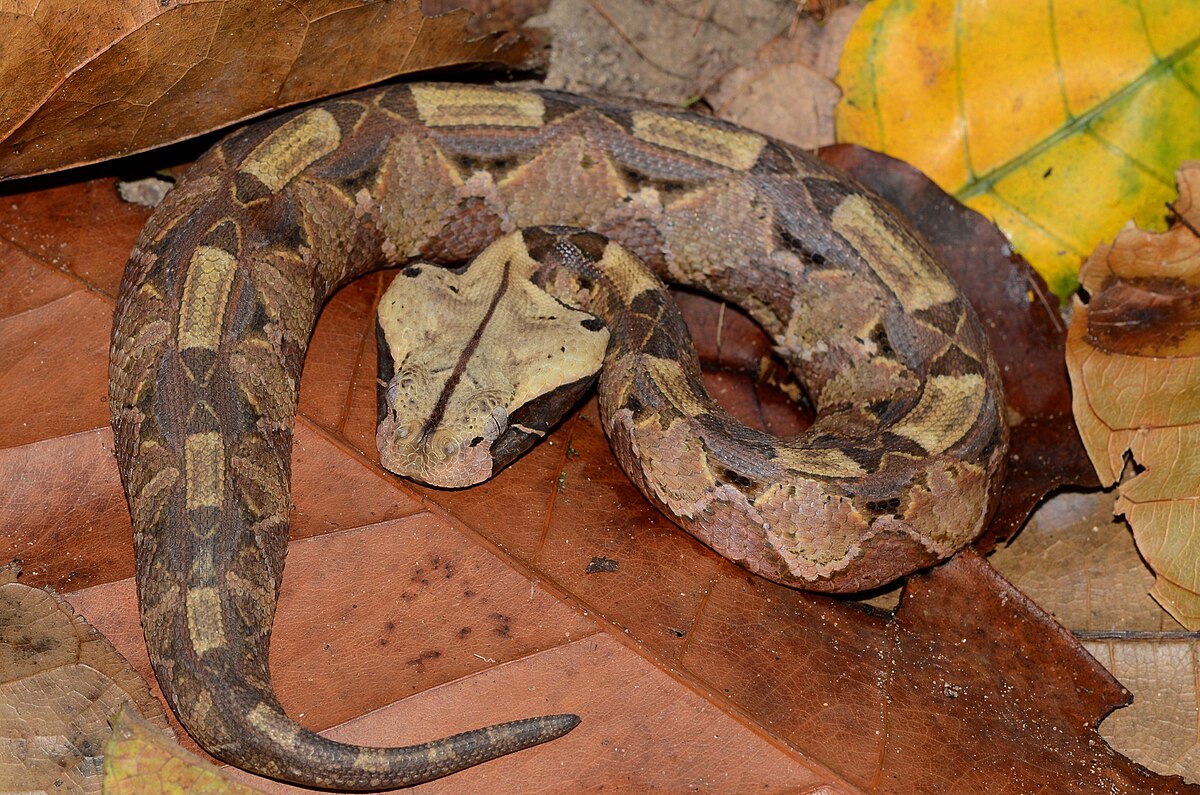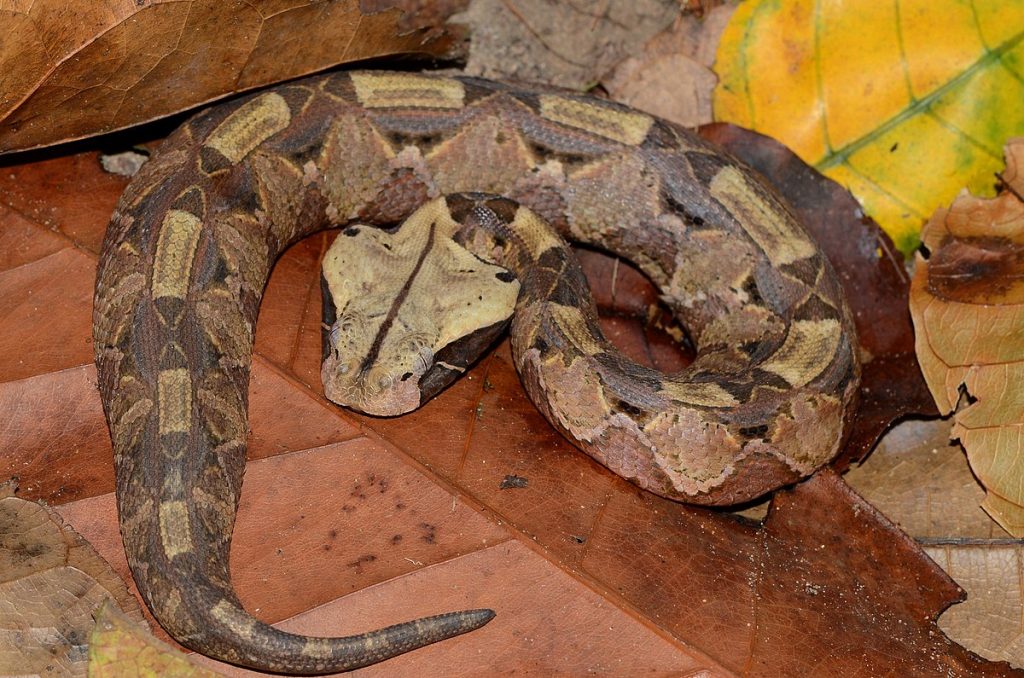Gaboon vipers, also known as Gaboon adders, are considered one of the largest venomous snakes in Africa. These majestic creatures can grow up to six feet long and weigh up to 18 pounds. But where exactly can you find them?
Gaboon vipers are native to the rainforests of central and western Africa. They can be found in countries such as Cameroon, Gabon, Nigeria, and the Congo. These snakes are known for their impressive camouflage, making them difficult to spot in their natural habitat. Let’s dive deeper into the world of Gaboon vipers and explore where they call home.
Gaboon vipers are found in the rainforests and savannas of sub-Saharan Africa, including countries such as Cameroon, Gabon, and Congo. They prefer to live in areas with thick vegetation and water sources.

Where Are Gaboon Vipers Found?
Gaboon vipers are known for their large size and deadly venom. They are one of the largest vipers in the world, and can be found in a variety of habitats throughout Africa. In this article, we will explore where Gaboon vipers are found and what makes their habitat suitable for their survival.
Location
Gaboon vipers are primarily found in the tropical rainforests of central and western Africa. They can be found in countries such as Cameroon, Gabon, Congo, and Nigeria. These snakes are also found in other habitats such as swamps, riverbanks, and even mangrove forests. Due to their large size and camouflage, they can be difficult to spot in the wild.
Gaboon vipers prefer to live in areas with thick vegetation and plenty of ground cover. This allows them to hide from predators and hunt for prey. They are also known to live near water sources such as rivers and streams.
Habitat
The Gaboon viper’s habitat is essential for its survival. These snakes are ambush predators, meaning they wait for their prey to come to them. Their large size and excellent camouflage make them well-suited for this hunting style. They often hide in the leaves and wait for small animals to pass by.
Gaboon vipers are also known for their ability to adapt to their environment. They can survive in both humid and dry conditions, and are known to move to new areas in search of food and shelter.
Behavior
Gaboon vipers are generally solitary animals, only coming together during mating season. They are also known for their slow movement and patience when hunting. They can wait for days in the same spot for prey to come by.
These snakes are also highly venomous, making them a danger to humans and other animals. They use their venom to immobilize their prey and defend themselves from predators.
Diet
Gaboon vipers are carnivorous, meaning they only eat meat. They generally feed on small mammals such as rodents, as well as birds and other reptiles. Their large size allows them to consume larger prey than other snakes.
Gaboon vipers are also known for their unique hunting style. They have long fangs that fold back into their mouth when not in use. When they strike, the fangs extend forward and inject venom into their prey.
Reproduction
Gaboon vipers are oviparous, meaning they lay eggs. They typically lay between 12-20 eggs at a time, which hatch after approximately 3 months. The young snakes are born fully formed and able to hunt for themselves.
Mating season for Gaboon vipers occurs during the rainy season, which varies depending on the location. During this time, males will compete for females by engaging in combat.
Threats and Conservation
Gaboon vipers are considered a vulnerable species due to habitat loss and poaching. They are often hunted for their skin, which is used in traditional medicine and the exotic pet trade.
Conservation efforts are being made to protect Gaboon vipers and their habitat. These efforts include the creation of protected areas and educating local communities about the importance of preserving these snakes and their environment.
Benefits of Gaboon Vipers
Gaboon vipers play an important role in their ecosystem as both predator and prey. As predators, they help control populations of small mammals and other animals. As prey, they provide food for other animals such as birds of prey and larger snakes.
Gaboon vipers also have potential medicinal benefits. The venom of these snakes contains compounds that have been used to treat hypertension, blood clots, and other medical conditions.
Gaboon Vipers vs Other Snakes
Gaboon vipers are often compared to other large vipers such as the bushmaster and the king cobra. While these snakes share some similarities in size and venomous abilities, they have distinct differences in their appearance and behavior.
Gaboon vipers are known for their large, triangular heads and distinctive patterns on their scales. They are also more patient hunters than other vipers, waiting for their prey to come to them rather than actively seeking it out.
Conclusion
In conclusion, Gaboon vipers are fascinating and deadly creatures that are found in a variety of habitats throughout Africa. Their large size, unique hunting style, and venomous abilities make them an important part of their ecosystem. Conservation efforts are needed to protect these snakes and their habitat for future generations to enjoy.
Frequently Asked Questions
What is a Gaboon viper?
A Gaboon viper is a venomous snake species that is known for its distinctive triangular-shaped head and long fangs. It is considered one of the largest vipers in the world and is found in various parts of Africa.
These snakes are highly venomous and are responsible for many snakebite incidents in their native habitats. They are known for their passive behavior and are often camouflaged, making them difficult to spot in their natural environment.
What is the habitat of Gaboon vipers?
Gaboon vipers are found in various parts of Africa, including the rainforests and savannas of West and Central Africa. They prefer to live in areas with heavy vegetation, including the edges of forests, swamps, and riverbanks.
They are also known to inhabit areas near human settlements, which can put them in conflict with humans. Gaboon vipers are nocturnal, which means they are most active at night and are less likely to be seen during the day.
How do Gaboon vipers hunt for their prey?
Gaboon vipers are ambush predators that use their camouflage to blend into their surroundings and wait for their prey to come near. They have a keen sense of smell that helps them detect prey, and they use their long fangs to inject venom into their victims.
They primarily feed on small mammals such as rodents, but they have also been known to eat birds and other snakes. Once they have captured their prey, they use their powerful muscles to constrict it and swallow it whole.
What is the venom of Gaboon vipers like?
The venom of Gaboon vipers is highly toxic and contains a combination of different enzymes and toxins. It can cause severe pain, swelling, and tissue damage, and can even be fatal if left untreated.
However, the venom of Gaboon vipers is not always lethal, and many people who are bitten by these snakes can recover with proper medical treatment. Antivenom is available to treat Gaboon viper bites, but it is important to seek medical attention as soon as possible after being bitten.
What is the conservation status of Gaboon vipers?
Gaboon vipers are listed as a species of least concern by the International Union for Conservation of Nature (IUCN). However, they are still threatened by habitat loss and fragmentation, as well as hunting by humans for their skin and meat.
Conservation efforts are underway to protect the habitats of Gaboon vipers and to raise awareness about the importance of these snakes to the ecosystem. These efforts include habitat restoration, anti-poaching measures, and public education campaigns.
In conclusion, Gaboon vipers are found exclusively in the dense forests of sub-Saharan Africa, from Guinea to Tanzania. Their unique appearance and deadly venom make them a fascinating species to study and learn about. While Gaboon vipers may seem intimidating, it’s important to remember that they play a vital role in their ecosystem and should be respected from a safe distance. If you ever find yourself in their natural habitat, be sure to keep your eyes peeled and stay vigilant of your surroundings. But for most of us, the best way to admire these incredible creatures is from afar, through photographs and documentaries.

